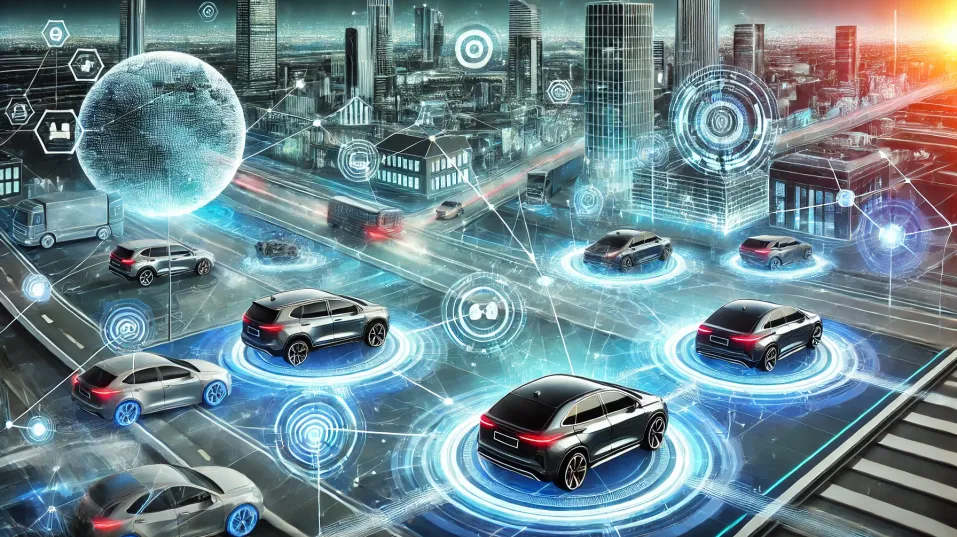Connected Vehicles Explained: Driving the Future with Smart Technology

Connected vehicles, also called smart vehicles, are built with advanced technologies that can be linked to other devices and services, allowing communication via a network. The connectivity permits features such as safety, entertainment and navigation, and remote access to the vehicle functionality.
The connection works through Internet of Things (IoT) technologies, sensors, onboard computing systems, and 5G wireless communication protocols
How Connected Vehicles Work?
A connected vehicle is always connected to the internet, allowing drivers to use features like:-
1. Data Collection in Connected Vehicles
Sensors
Connected vehicles are integrated with a wide range of sensors. This includes radar, LiDAR, GPS, etc. These sensors monitor various features of the connected and autonomous vehicle & its surroundings.
Information Gathering
These sensors collect data about the vehicle, including speed, acceleration, location, road conditions, surrounding traffic, & more.
2. Data Processing and Transmission in Connected Vehicles
Telematics System
The sensors will transmit the data to the telematics system of the connected autonomous vehicle. This behaves as a Central Processing Unit.
Connectivity
The telematic system uses Bluetooth, Wi-Fi or cellular network to transmit the data to the central server or cloud.
Data Analysis
The collected data is analysed by the advanced algorithm of the connected autonomous vehicles. Using this, the insights are generated and potential issues are predicted. Also, it gives real-time alerts to the person who is driving and other systems.
3. Communication and Interaction in Connected Vehicles
Vehicle-to-Everything (V2X)
These vehicles can communicate with devices (V2D) like connected car devices, Infrastructure (V2I), & even other vehicles (V2V) like connected cars. For this, wireless technologies are used.
Information Sharing
This communication allows vehicles like connected cars to share information. This includes details about road hazards, accidents, traffic congestion, & even the health status of connected autonomous vehicles.
Enhanced Safety and Efficiency
By sharing and receiving data, vehicles like connected cars offer an improved overall driving experience. It can optimise traffic flow and prevent accidents.
Over-the-Air Updates
Connected vehicles can also get software updates & new features over the air. It is similar to smartphones.
4. Key Components and Technologies in Connected Vehicles
Types of connectivity systems
Currently, connected vehicles use two main types of connectivity systems:
1. Embedded System:
These cars have a built-in chipset and antenna inside the vehicle. This system manages data and helps send and receive signals directly from the car, with no need for any external device.
2. Tethered System:
In this setup, the car connects to the driver’s smartphone using special hardware. The phone helps the car go online and communicate.
Internet of Things (IoT)
Vehicle technology, such as Connected car technology, is a key part of the broader Internet of Things ecosystem. It allows seamless integration with other smart devices and systems.
5G and Cloud Computing
High-speed cloud computing platforms & 5G networks are crucial for enabling the fast data processing and communication required for the applications of connected autonomous vehicles.
How Do Connected Vehicles Communicate?
Connected vehicles can communicate using different types of communication protocols & technology. They are collectively known as Vehicle-to-Everything (V2X) communication.
- Vehicle to Infrastructure (V2I):
Vehicles like connected cars communicate with roadside units & other infrastructure components. This can be your road signs & traffic lights. It enables the vehicle to collect data regarding the road hazards, traffic conditions, and other relevant data.
This connected vehicle technology can help in optimising routes, avoiding congestion, & even coordinating with traffic signals. - Vehicle to Everything (V2X):
This combines all types of communication (V2V, V2I, & more). It gives the driver real-time updates and data, helping make driving safer, smarter, & more efficient. - Vehicle to Vehicle (V2V):
Connected vehicles exchange data with each other directly. This includes details of direction, speed, and location. Using them, one can attain the real-time information related to the surroundings of the vehicles. This can potentially improve traffic flow and prevent collisions.
Thereby, improving both driving safety and efficiency. The V2V communication system, combined with ADAS system features, enables vehicles to predict the movements of surrounding vehicles, which decreases the risk of accidents.
Cars gain the ability to operate with traffic lights and road signs through V2I, thus enabling them to change speeds or directions while traffic flows or construction areas exist. Through V2P communication, vehicles can identify pedestrians and cyclists, which prevents accidents. The V2N communication connects vehicles to cloud systems and traffic management centres for data-driven decisions.
Key Aspects of V2X Communication Include:
- The V2V communication technology enables vehicles to transmit exact location data and exchange information and directional details for preventing crashes and traffic enhancement.
- Through Vehicle-to-Infrastructure (V2I) technology vehicles obtain access to shared data from traffic signals, road signs, and smart infrastructure, which leads to better traffic control and congestion reduction.
- The V2P system enables vehicles to share information with pedestrians and cyclists, thus improving safety via driver alerts.
- Vehicle-to-Network (V2N) establishes connections between automobiles and cloud services, traffic management systems & other networks for route optimisation, predicting traffic congestion, etc. It will provide drivers with the most up-to-date information for safer and more efficient driving experiences.
- Through V2X communication, vehicles can exchange data in real-time, thus providing critical information for quick decision-making during critical emergencies such as accidents and emergency responses.
- The connected ecosystem relies on V2X technology, which creates safer environments via enhanced management systems and enables the development of autonomous driving technology.
Why Choose Connected Vehicles?
Connected vehicles offer a personalized driving experience by adjusting settings based on your preferences and driving habits. They integrate seamlessly with smart devices, allowing for remote control and easy maintenance scheduling. Additionally, connected vehicles provide enhanced security and convenience through features like remote door locking and climate control. Lastly, they tend to have higher resale values due to their modern technology and functionality.
Key Benefits of Connected Vehicles
Connected vehicles are revolutionising how we drive by offering a wide range of benefits that enhance safety, efficiency, and convenience. By leveraging advanced communication systems, ADAS, and real-time data, these vehicles are transforming the driving experience in meaningful ways.
- Enhanced Safety: Connected vehicles use real-time data sharing to notify drivers about upcoming accidents by intimating about critical pavement and detecting pedestrians. The system implements features, such as collision avoidance, emergency braking, and lane-keeping assistance, which decrease the possibility of accidents.
- Traffic and Route Optimisation: The exchange of data through V2X communication lets vehicles track real-time traffic information, which enables them to reroute in different directions and shorten their travel time.
- Improved Fuel Efficiency: Route information delivered in real-time allows connected vehicles to improve their driving patterns which in turn minimises their fuel usage. The environmental impact decreases through reduced emissions that result from both efficient route planning and smooth accelerating techniques.
- Predictive Maintenance: The sensors embedded in connected vehicles steadily track the condition of the vehicle. It detects necessary maintenance requirements and activates driver alerts or report updates to facilitate the service, which reduces breakdown unpredictability and repair expenses.
- Autonomous Driving Support: The main infrastructure that supports autonomous vehicles is a fundamental part of connected car networks. This technology enables autonomous vehicles to access real-time data. This helps in improving steering decisions and navigation for a smarter & automated future.
- Better Emergency Response: During emergencies, connected vehicles can automatically share alerts with precise locations for emergencies. It will help in enabling quick response with better outcomes for victims.
- Improved Parking Solutions: Connected vehicles use parking infrastructure communication to help drivers locate empty parking spots in busy areas thus decreasing search time and reducing urban congestion.
Challenges for Connected Vehicles
The major challenges and concerns while leveraging connected vehicles will be:
- Cybersecurity Risks: The availability of data and internet connectivity makes connected vehicles vulnerable to attacks by hackers. Vehicle systems face the risk of malicious attacks, which might result in safety hazards and personal data theft.
- Privacy Concerns: Connected vehicles continuously gather and distribute data, which includes their position, driving patterns, and health-related information. The handling of this information by data storage services creates multiple privacy concerns about data access limitations and possible wrongful use of user information.
- Infrastructure Limitations: Connected vehicles require complete smart infrastructure features to operate at their best including traffic lights, road signs and sensors. The complete deployment of connected vehicle infrastructure will remain unfinished in numerous areas because of which these connected car operate less efficiently.
- High Implementation Costs: You must spend considerable amounts of money to implement the technology for connected vehicles because these systems use sensors together with advanced communication systems and AI. The cost stands as a common challenge.
- Regulatory and Legal Challenges: The rapid development of connected vehicle technology has raised regulatory uncertainties in this sector. Public safety, data protection, etc., must be considered when establishing regulations for connected vehicles.
- Interoperability Issues: The use of different communication protocols by manufacturers creates obstacles for connected vehicles to exchange information between different brands and networks which reduces the effectiveness of the technology.
Connected vehicles are reshaping the future of transportation with their advanced technologies, offering numerous benefits like enhanced safety, improved efficiency, and smarter mobility. While challenges such as cybersecurity, privacy concerns, and infrastructure limitations remain, the potential of connected vehicles to transform our driving experience is undeniable. As technology continues to evolve and integration improves, these vehicles will play a pivotal role in creating a safer, more efficient, and sustainable transportation ecosystem. Embracing connected vehicles today is a step toward a smarter, more connected world on the road.
